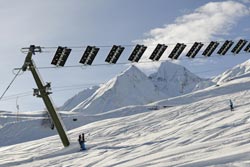The world’s first solar ski lift equipped with Siemens technology

The “Skilift Tenna” (GST) cooperative opted for technology from Siemens’ Industry Automation Division to modernize its drag-lift.
Since its commissioning in late 2011, the solar ski lift has produced three times more solar power than that required to operate it and has doubled the number of people it can transport.
The 460 meter long drag-lift is located at an altitude of 1644 meters in the holiday resort of Tenna and required refurbishing after 40 years in operation. To achieve this, GST opted for a combination of a photovoltaic system and automation.
The newly installed photovoltaic equipment associated with the drag-lift is based on a solar wing system, whereby 82 photovoltaic modules forming socalled solar wings are hung between two ropes and automatically track the position of the sun.
The system produces a total power of about 90,000 kWh per year, two-thirds of which are fed back into grid at market prices, using Sinvert PVM string inverters.
The draglift’s operation involves a significant number automation components. A Simatic S7 programmable logic controller, enhanced with a fail-safe CPU and ET 200S modules, control the ski lift‘s operation. The refurbishment made it possible to double the hourly transport capacity to 800 persons.
The exchange of data between the lift’s mountain and valley stations is also based on Siemens technology, using an IM 151-3 interface module from the ET 200S distributed peripherals range.
The entire ski lift system in Tenna is operated using a Simatic Touch Panel.
Media Contact
All latest news from the category: Power and Electrical Engineering
This topic covers issues related to energy generation, conversion, transportation and consumption and how the industry is addressing the challenge of energy efficiency in general.
innovations-report provides in-depth and informative reports and articles on subjects ranging from wind energy, fuel cell technology, solar energy, geothermal energy, petroleum, gas, nuclear engineering, alternative energy and energy efficiency to fusion, hydrogen and superconductor technologies.
Newest articles

Sea slugs inspire highly stretchable biomedical sensor
USC Viterbi School of Engineering researcher Hangbo Zhao presents findings on highly stretchable and customizable microneedles for application in fields including neuroscience, tissue engineering, and wearable bioelectronics. The revolution in…

Twisting and binding matter waves with photons in a cavity
Precisely measuring the energy states of individual atoms has been a historical challenge for physicists due to atomic recoil. When an atom interacts with a photon, the atom “recoils” in…

Nanotubes, nanoparticles, and antibodies detect tiny amounts of fentanyl
New sensor is six orders of magnitude more sensitive than the next best thing. A research team at Pitt led by Alexander Star, a chemistry professor in the Kenneth P. Dietrich…





















